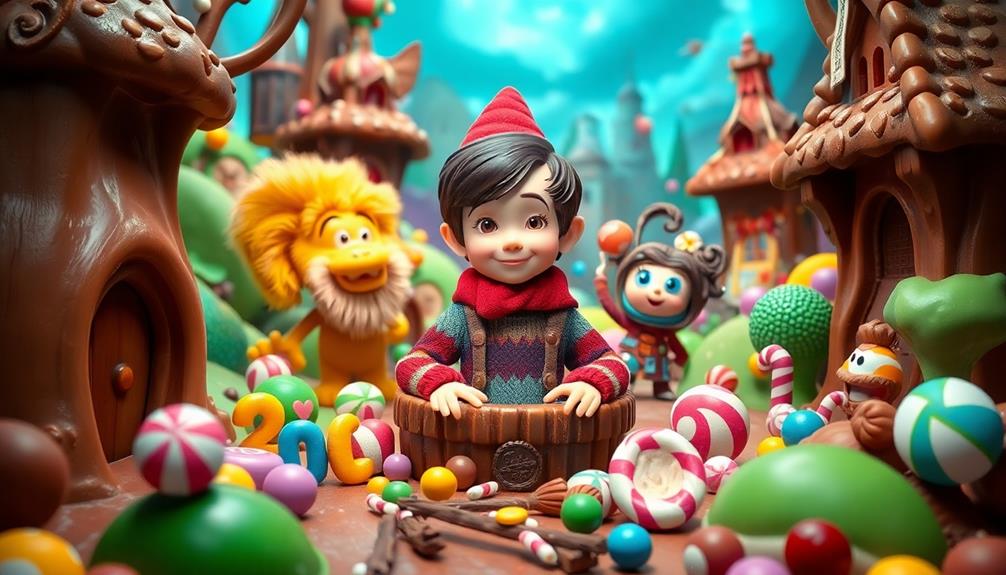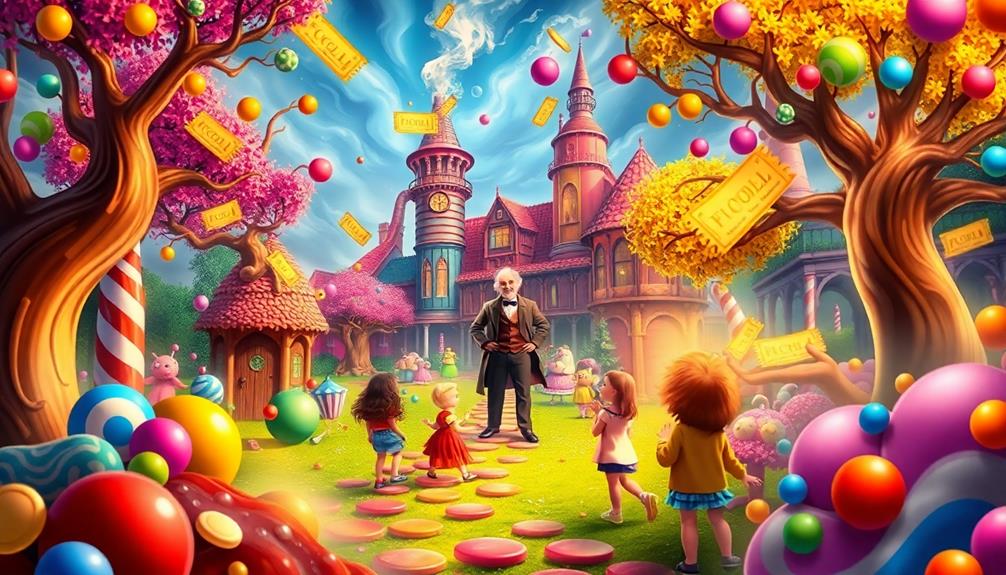When you explore Roald Dahl's mind behind "Charlie and the Chocolate Factory," you're transported into a fantastical domain filled with candy and moral lessons. Dahl's unique characters, like the kind-hearted Charlie Bucket and the flawed golden ticket winners, showcase his understanding of human nature. His childhood experiences and personal tragedies shaped his storytelling, adding emotional depth to the whimsical narrative. As you uncover themes of integrity versus greed, you can see how Dahl's imagination transforms challenges into creativity. There's so much more to discover about his inspirations and how they influenced this beloved classic.
Overview of the Book
In "Charlie and the Chocolate Factory," Roald Dahl takes you on a whimsical journey into a world of candy and imagination. The story centers around Charlie Bucket, a poor boy who dreams of a better life. When he stumbles upon a golden ticket hidden inside a Wonka Bar, his life changes forever. This ticket grants him access to Willy Wonka's magical chocolate factory, a place filled with fantastical creations and eccentric characters.
Dahl's narrative, much like the masterful portrayal of human resilience seen in David Copperfield, dives deep into themes of morality and the consequences of one's actions. As Charlie navigates the factory with four other ticket winners, you witness the stark contrast between his humble nature and the negative traits of the other children. Each child's character flaws lead to their downfall, showcasing the importance of kindness and respectfulness.
Willy Wonka, the enigmatic chocolatier, guides the children through his whimsical world, embodying creativity and whimsy. As the tale unfolds, it becomes clear that Charlie's goodness is ultimately rewarded, leading to his unexpected inheritance of the chocolate factory.
This classic story remains cherished in children's literature, making it a timeless adventure for readers of all ages.
Plot Summary
In "Charlie and the Chocolate Factory," you follow Charlie Bucket, a kind-hearted boy from a poor family, as he stumbles upon the last golden ticket.
This ticket leads him into Willy Wonka's whimsical factory, a magical domain that mirrors the enchanting worlds found in epic quests and magical domains, where he and four other children face the consequences of their bad behavior.
Through their journeys, you see how Charlie's humility and respectfulness ultimately reward him in a way the others can only dream of.
Charlie's Humble Background
Poverty shapes Charlie Bucket's life, defining his humble background and the world he inhabits. Living in a small, rundown house with his parents and four grandparents, you see how the Bucket family endures extreme financial hardship. As a poor boy, Charlie often goes hungry, making his struggles palpable.
Yet, amidst this scarcity, the love and support of his family shine through, showcasing their unbreakable bonds in the face of adversity.
Charlie's humble circumstances starkly contrast with the wealth and extravagance of Willy Wonka's chocolate factory. While the world outside his door buzzes with luxury, Charlie's life revolves around modesty and survival. His family's daily sacrifices highlight not only their poverty but also their resilience.
The discovery of the last golden ticket becomes a pivotal moment for Charlie, symbolizing hope and the potential for a brighter future. It ignites a spark of possibility, suggesting that even a poor boy from a struggling family can dream of something extraordinary.
As you dive deeper into Charlie's story, you realize that this ticket isn't just a pathway to chocolate; it's a chance for transformation and adventure.
The Golden Ticket Adventure
The magical adventure begins when Charlie Bucket discovers the last golden ticket hidden in a Wonka bar, opening the gates to Willy Wonka's extraordinary chocolate factory. You can feel the excitement as Charlie joins four other ticket holders—Augustus Gloop, Violet Beauregarde, Veruca Salt, and Mike Teavee. Each child embodies negative traits, creating a stark contrast to Charlie's humble nature.
As you journey through the factory, you witness amazing sights and temptations, including:
- Chocolate River: A flowing river of rich chocolate, enchanting everyone's attention.
- Inventing Room: Where Wonka's wild creations come to life, showcasing his genius.
- Nut Room: Home to squirrels that sort nuts, revealing the magic of Wonka's world.
Throughout the adventure, Charlie's kindness shines as he navigates the challenges posed by the other children. While they face bizarre consequences for their gluttony and selfishness, Charlie's humble demeanor ultimately leads to an unexpected reward.
Consequences for Bad Behavior
Consequences loom for bad behavior as Charlie Bucket's fellow golden ticket holders face their fates in Willy Wonka's factory.
Each child, embodying a particular flaw, serves as a cautionary tale about the repercussions of their actions. Augustus Gloop's insatiable gluttony leads him to tumble into the chocolate river, where he gets stuck in a pipe, illustrating the dire consequences of overindulgence.
Violet Beauregarde's relentless obsession with gum transforms her into a giant blueberry after she samples an experimental treat, showcasing the dangers of selfishness and impatience.
Meanwhile, Veruca Salt's spoiled demeanor results in her being unceremoniously tossed down a garbage chute by squirrels, a stark reminder of the repercussions that come from entitlement and bad behavior.
Character Analysis

Five distinct children, each representing a different flaw, journey through Willy Wonka's whimsical factory, showcasing the stark contrasts in their character traits. You see Charlie Bucket, the embodiment of innocence and resilience, supported by his loving Grandpa Joe.
In stark contrast, Augustus Gloop's gluttony leads him to an unfortunate fate, falling into the chocolate river. This exploration of character flaws mirrors the intricate plotting found in historical mysteries, such as those in the enchanting narrative of *The Daughters of Night*, where societal challenges shape the characters' journeys.
The characters each highlight essential flaws through their actions:
- Greed: Violet Beauregarde's impulsiveness and need to win make her chew the experimental gum, resulting in her transformation into a blueberry.
- Selfishness: Veruca Salt's bratty behavior earns her a swift punishment as the squirrels discard her down a garbage chute.
- Innocence: Charlie's humble nature and grounded upbringing allow him to navigate the factory's challenges with grace, unlike the other children.
Willy Wonka, the whimsical guide, tests these traits, revealing the moral fabric of each child.
While Charlie emerges as the moral victor, the fates of Augustus, Violet, and Veruca serve as cautionary tales, emphasizing the consequences of their inherent flaws in *Charlie and the Chocolate Factory*.
Themes and Morals
In *Charlie and the Chocolate Factory*, the themes and morals become evident as the fates of Augustus, Violet, Veruca, and Mike unfold. Each child faces consequences that reflect their negative traits, serving as cautionary tales about greed, selfishness, and the dangers of consumerism. Augustus' gluttony leads him to be sucked into a chocolate river, while Violet's obsession with winning makes her swell into a blueberry.
Through these events, you see how Dahl critiques the indulgent behaviors that modern society often glorifies. This critique echoes the idea that embracing inner strength and personal growth, as highlighted in unlocking hidden talents, is essential for a fulfilling life.
In stark contrast, Charlie Bucket embodies kindness and humility. His virtuous character ultimately leads to his success, emphasizing that true happiness comes from love and integrity rather than material wealth.
The Oompa-Loompa songs reinforce these themes, delivering moral lessons about the importance of good behavior. They remind you that poor choices result in fitting consequences, while virtues like kindness pave the way to rewards.
Ultimately, Dahl's narrative highlights the significance of family bonds and ethical behavior. By portraying these contrasting characters, he teaches that character matters more than possessions, leaving you with a lasting message about the importance of integrity in life.
Dahl's Inspirations and Challenges

Roald Dahl's journey in writing "Charlie and the Chocolate Factory" was shaped by both his childhood experiences and profound personal tragedies.
His early years in a diverse environment, much like the immigrant experience depicted in early 20th-century Brooklyn, influenced his storytelling.
You'll see how the chocolate samples from Cadbury sparked his imagination, while the loss of his children influenced the story's emotional depth.
His ability to transform challenges into creativity highlights the resilience that marks his work, echoing themes of immigrant resilience found in literature.
Early Inspirations From Childhood
Though Dahl dreamed of inventing new chocolate treats, life took him on various adventures. Here are three key experiences that shaped his early inspirations:
- Working for Shell Oil, where he discovered the importance of storytelling in business.
- Serving in the Royal Air Force during World War II, which exposed him to diverse characters and situations.
- Meeting novelist C.S. Forester in Washington, D.C., who encouraged him to pursue writing seriously.
These experiences, along with his childhood encounters with confectionery, laid the foundation for Dahl's work in children's literature.
His imaginative spirit, fueled by sweet treats and real-life adventures, ultimately led to his lasting legacy as a master storyteller, enchanting generations of readers with his unique blend of whimsy and wonder.
Personal Tragedies and Writing
Amid the sweetness of his whimsical tales, Dahl grappled with profound personal tragedies that shaped both his life and writing. His son Theo's severe injuries in a stroller accident forced him to pause his career, focusing on his child's recovery. This experience tested his emotional state, igniting a sense of helplessness that would later fuel his creative narrative.
Tragically, after returning to England in 1961, Dahl faced the devastating loss of his daughter Olivia to measles complications, plunging him deeper into grief.
These personal tragedies didn't just darken his world; they added depth to his writing. You can see how themes of loss and resilience emerge in works like "Charlie and the Chocolate Factory." Dahl channeled his pain into his characters, crafting whimsical yet poignant storytelling that resonates with readers.
Despite the hardships, he showcased an incredible ability to blend his life experiences with imaginative plots, creating beloved characters who reflect both joy and sorrow. Ultimately, Dahl's resilience in the face of adversity allowed him to leave a lasting literary legacy, transforming his personal grief into timeless tales that continue to capture hearts.
Challenges During Creation Process
Often, creative endeavors are born from a mix of inspiration and adversity, and "Charlie and the Chocolate Factory" is no exception. While writing this classic, Dahl faced significant challenges that deeply influenced his work. His early experiences at Repton School, where he received chocolate samples from Cadbury, sparked his imagination.
However, during the creation process, personal tragedies loomed large.
Here are three major challenges Dahl encountered:
- Family Crises: The severe injury of his son Theo and the heartbreaking loss of his daughter Olivia cast a shadow over his writing.
- Emotional Turmoil: These experiences filled Dahl with feelings of loss and helplessness, which he channeled into the emotional depth of his story.
- Resourcefulness: His collaboration with a toymaker to create the Dahl-Wade-Till valve exemplified his determination to overcome adversity for his family's sake.
Despite these hardships, Dahl wrote with perseverance, transforming his sorrow into a tale that resonated with readers. "Charlie and the Chocolate Factory" emerged not just as a beloved classic but also as a reflection of Dahl's resilience and creative spirit amidst personal strife.
Cultural Impact and Adaptations
Roald Dahl's "Charlie and the Chocolate Factory" has left an indelible mark on popular culture, inspiring a plethora of adaptations that capture the imagination of audiences worldwide. Themes of passion and personal growth, as seen in Tita's journey, resonate with the struggles of characters in Dahl's work.
You'll find two major film adaptations that stand out: the beloved 1971 classic, "Willy Wonka & the Chocolate Factory," featuring Gene Wilder, and Tim Burton's 2005 version starring Johnny Depp. Each brings a unique interpretation to Charlie's enchanting world, showcasing Roald's timeless story in different lights.
The 1971 film is cherished for its whimsical portrayal and memorable songs, making it a staple for families. In contrast, the 2005 adaptation offers a darker, eccentric take on characters like Willy Wonka, which sparked mixed reviews.
Beyond films, the cultural impact of "Charlie and the Chocolate Factory" extends to stage adaptations, including a successful musical that debuted in London's West End in 2013 and later on Broadway.
Furthermore, the story has inspired themed products, from candy lines to various merchandise, celebrating the magic of Roald's creation. This continuous engagement with "Charlie" demonstrates its lasting influence and the profound connection it maintains with audiences of all ages.
Conclusion
In exploring Roald Dahl's "Charlie and the Chocolate Factory," you uncover the magic of imagination and creativity. Did you know that the book has sold over 30 million copies worldwide? This staggering number highlights its lasting impact on readers of all ages. Dahl's whimsical storytelling and memorable characters continue to resonate, reminding us of the importance of dreams and the adventures that await when we dare to believe in the extraordinary.



